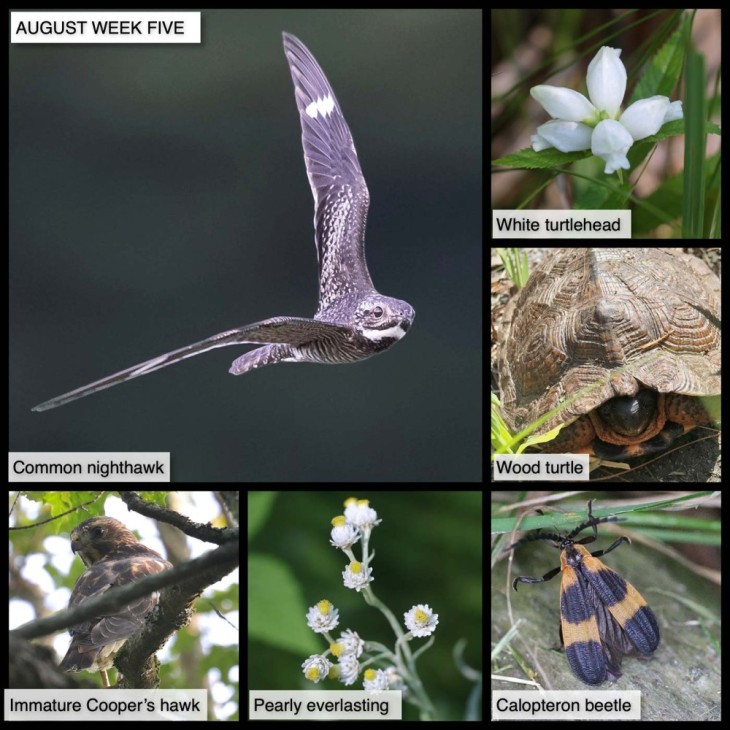This Week in the Woods, it’s common nighthawk migration season, and in what has become an annual tradition, Tig Tillinghast staked out a local dam site and riverside fields at dusk to photograph the birds as they hunted flying insects. Here’s an Outside Story essay by Brett Amy Thelen, describing these remarkable birds – listed as “endangered” in Vermont and New Hampshire, “threatened” in Canada – which are heading out now for their winter habitat in South America. They’re a joy to watch fly – incredibly acrobatic in their pursuit of prey.
Here are some other nature sights this week (clockwise):
We found white turtlehead blooming among the grasses in a soggy beaver meadow. This wetland wildflower is named for the shape of its blooms, which do look (sort of) like turtle heads, with the upper and lower petals pressed together to form a “mouth.” As noted in this profile from The Native Plant Trust, bumblebees and hummingbirds are turtlehead’s main pollinators, which makes sense, as a visitor needs a fair amount of heft to pry apart the petals and access the pollen and nectar.
Speaking of turtles, we escorted this wood turtle across a busy road, and took a quick phone photo in the process. Here’s an article by John Litvaitis from the Spring 2018 issue of Northern Woodlands magazine, explaining that this species, which used to be common in our region, requires much longer to reach sexual maturity – about 14-18 years – compared to painted turtles’ six years or less. He also explained that it doesn’t take much more loss than natural mortality rates for a local population of wood turtles to disappear; just a few car fatalities represents a major loss. So watch out for them, and help them cross the pavement safely.
There are two look-alike species of Calopteron beetle (C. discrepans and C. reticulatum), that have the coloring and form of the insect in the photo. Both are active now, and you’ll often find them on flowers. Check out their chainsaw blade antennae! Calopteron beetles are part of the net-winged beetle Lycidae family, which generally have a pattern of feeding on fungi as larvae and on nectar and honeydew as adults. They also often are steeped in toxins, and as with other insects with aposematic coloring (ex. black and orange monarch butterflies), their eye-catching looks serve as a warning to would-be predators. Here’s the bugguide.net page related to C. reticulatum.
Tough, leggy, and not especially fussy about habitat, pearly everlasting grows across our region and is blooming now. The yellow centers are the actual flower and will fade, but the white outer bracts – which, at a glance, look like petals – are much more durable and will linger on well into autumn. As noted in this profile from the U.S. Forest Service, there’s a rich history of human use of this wildflower: for example, in treatments for colds and rheumatism.
Finally, in a redux of our recent close encounter with a young barred owl (see this blog’s August Week Three), we had the strange experience of a young Cooper’s hawk landing right next to us on a branch. It seemed to think it was hidden. Cooper’s hawks are woodland fliers, built to maneuver in tight spaces, and they’re often described as bird hunters (although they also take their share of chipmunks). At this time of year, young birds may still be awkward fliers. (Although hard to see in this image, this bird also had yellow eyes – a trait of immature Cooper’s hawks). Here’s an Outside Story article about them by Carolyn Lorié.
Our thanks to The Bailey Charitable Foundation and the Frank and Brinna Sands Foundation for helping to support this series.
In this difficult period, many of us find joy in observing local nature. This series, launched in April 2020, shares nature photographs taken in the past seven days, or in the same week in 2020, most within 15 miles of the Northern Woodlands office in Lyme, New Hampshire. We hope you enjoy using this grid as a prompt for your own explorations.
What are you seeing in the woods this week? Share your images with us on Facebook, or submit a special photo for possible inclusion in our monthly online Reader Photo Gallery.


